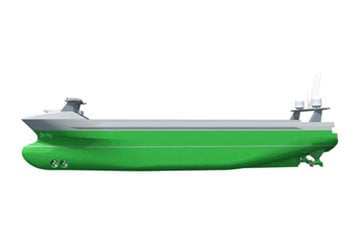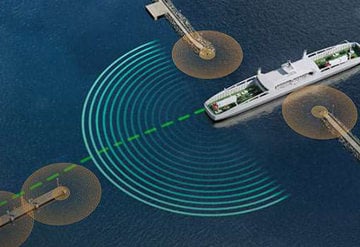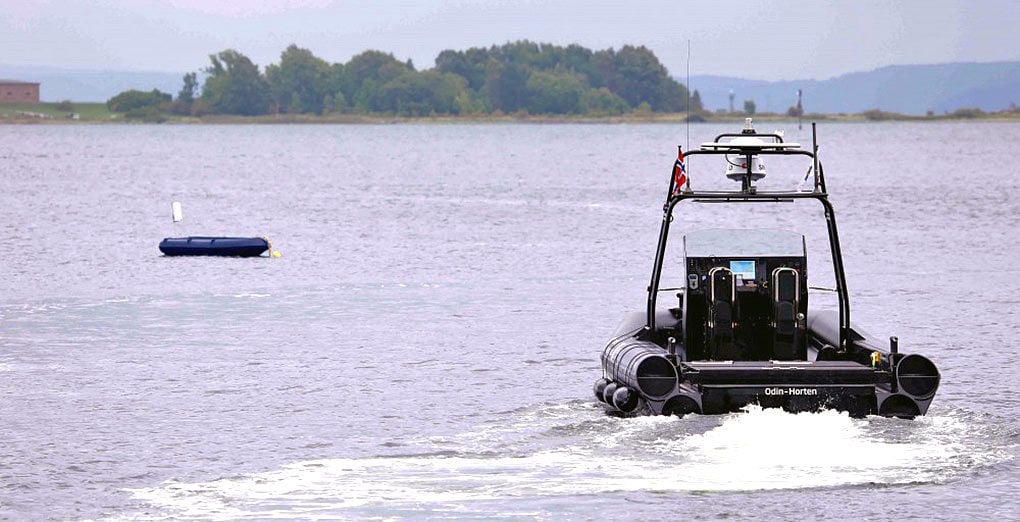
Autonomous future
Autonomous vessels are about to become a reality. KONGSBERG has become a world leader in this development.
There is a rubber dinghy docked in the harbour in Horten. Odin is thundering towards it. The boat belongs to the Norwegian Defence Research Establishment (FFI) and is a test platform for autonomous technology.
In collaboration with Kongsberg Maritime, FFI has developed the autonomous “brain” which controls Odin. The remote control has been put away. Now it's up to Odin herself to avoid collision with the rubber dinghy.
- We'll see now if she goes to the starboard or port side of the obstacle. The boat makes this decision herself, the people in attendance are informed over the loudspeaker system.
Odin's on-board radar detects the rubber dinghy first. Then so does the lidar - a rotating laser that sends a three-dimensional image of the surroundings back to Odin's “brain”.
Suddenly, Odin turns sharply to starboard and elegantly swings in a large arc around the rubber dinghy, before continuing on the same course. Applause is heard from dry land. Odin has demonstrated her mastery of a basic feature within autonomy - avoiding collision.
Civil applications
Odin is one of several projects where KONGSBERG is working on self-driving vessels. In May 2017, Yara and KONGSBERG told the world about Yara Birkeland - the world's first self-driving freighter.
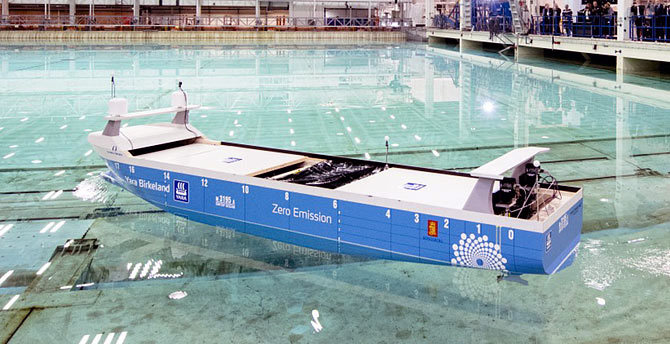
The plan is to launch the crewless, self-driving ship towards the end of 2018. The vessel will transport fertiliser between Porsgrunn and Brevik. With the aid of GPS, radar, cameras and sensors, the ship will be able to navigate, dock and leave the quay autonomously.
"For KONGSBERG this a unique opportunity to develop our technology and our sensors further. This is a concept with the potential to also be big internationally", said Geir Håøy, CEO of KONGSBERG.
In July, the offshore shipping company Bourbon and Automated Ship Ltd announced that KONGSBERG is to contribute to the design and operation of Hrönn, which will be the world's first self-propelled offshore vessel. According to the plan, the ship will be delivered in 2018.
Kongsberg Maritime is to supply the most important technical equipment for the ship, including navigation and steering, so that the ship can also be remotely controlled from land.
"We are delighted to collaborate with such great partners in the development of Hrönn, a vessel which will demonstrate how digitalisation and self-steering have the potential to revolutionise the offshore services market", said Stene Førsund, EVP of Global Sales and Marketing at Kongsberg Maritime.
Military applications
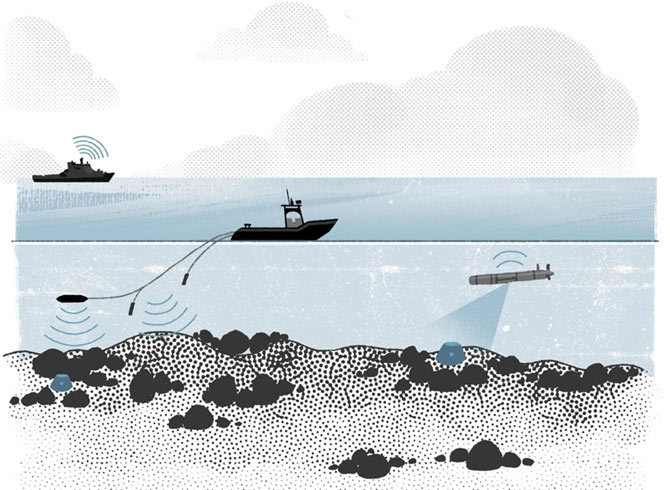
The work on making Odin autonomous is part of a greater focus on autonomy at FFI. Skills from across the entire institute have been gathered together to develop autonomy for unmanned systems on the sea, in the air and on land. The autonomous “brain” that controls Odin has been developed as part of the autonomy project in collaboration with Kongsberg Maritime.
In the future, the Norwegian Armed Forces plan to use unmanned surface vessels such as Odin to tow minesweepers. This job is currently performed by manned ships. Odin could also be used to map the seabed, and as a tug boat to tow the underwater vehicle HUGIN in and out of mined areas, states FFI on its website.
According to Morten Nakjem, head of the FFI's work on developing the mine system, there are many reasons to use autonomy when searching for mines.
"It's more effective, faster, less vulnerable, scalable, has a shorter production time, it's easier to train operators, it's cheaper, safer and requires fewer people than the current solution. This frees up staff to work on other tasks", Nakjem said in an article.
K-Mate
The technology used to control Odin autonomously has been named K-Mate and will come on to the market during 2018. K-mate is an autonomy control unit that enables self-propelled operation of almost any vessel as long as it has an electrical interface to the engine and control systems. Collision protection ensures that the vessel avoids obstacles detected by the vessel sensors.
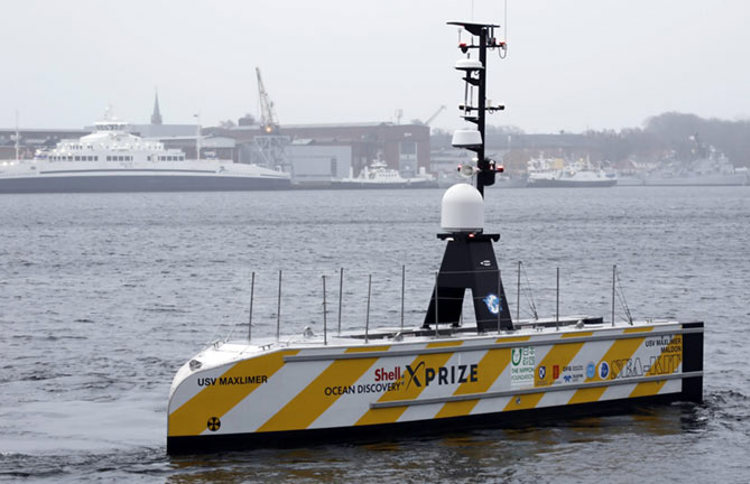
USING K-MATE: Acting as an autonomous ‘mother-ship' for KONGSBERG's Hugin AUV, SEA-KIT provides a next generation, long-range, long-endurance ocean capability that does not exist today.
"K-Mate has adaptive route point tracking for mapping and AUV operations. The system analyses real-time data from the distance sensors to avoid collisions. K-Mate is an autonomous system that performs according to a plan for globally monitored operations. However, direct operator interaction for complex tasks is also possible", said Stian Michael Kristoffersen, Product Manager for USV Solutions - Marine Robotics at Kongsberg Maritime.
Kongsberg Maritime has launched K-Mate as a common platform for the autonomous operation of unmanned and self-propelled vessels. It is connected directly to the electrical interface or to the on-board propulsion and steering system, either via autopilot or the vessel's dynamic positioning system.
This makes integration with nearly all vessels possible. KONGSBERG's own cloud-based platform Kognifai makes it possible to monitor self-propelled vessels all over the world.
"Operators can monitor the movements and collected data of the vessel or even take control of the vessel if necessary. Simple operational status is immediately available via Kognifai, which allows key personnel to monitor a vessel's status regardless of time or location", said Stian Michael Kristoffersen.
Several projects on the way
Autonomy is a technology area which represents a strategic priority for KONGSBERG. In addition to Yara Birkeland, Hrönn and Odin, Kongsberg Maritime is working on a range of other autonomy projects, either as a partner or as technology leader.
"The development of increasingly sophisticated automation is a very important step forward for the maritime industry. KONGSBERG's technology base gives us an important position in this market going forward", says Tom Eystø, Vice President of Bridge Systems at Kongsberg Maritime.
"What we will see over the next few years within maritime autonomy?"
"We are going to see a large degree of automation in standard vessels. Autonomous functions will be implemented for increased security, efficiency and reliability within all maritime operations", said Eystø.
Technology being tested in Trøndelag
In Trondheim, Kongsberg Seatex is well underway with the development of new sensor systems and the testing of new control systems. In May, the two driverless boats Ocean Space Drone 1 and Ocean Space Drone 2 were exhibited to the public during Ocean Week in Trondheim.
"We enjoy good collaboration with NTNU and SINTEF. They'l get to use these boats in their projects. There'l be an open platform, so we'l learn from each other's experiences with the vessels. The value of testing things cannot be underestimated", says Gard Ueland, President of Kongsberg Seatex.
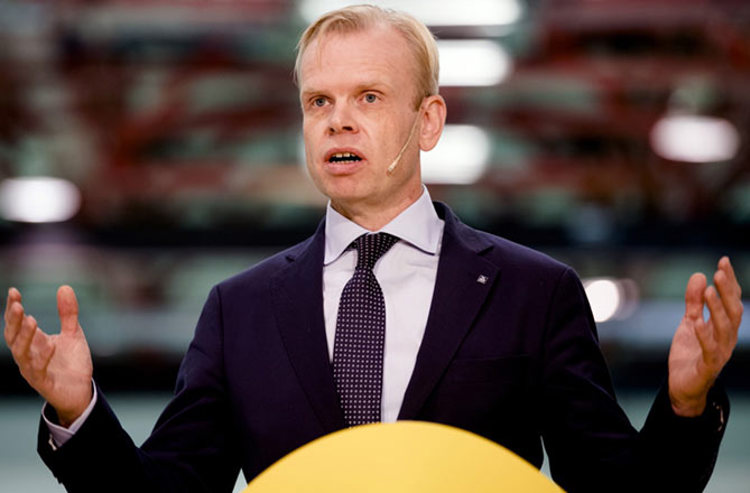
In September, a six-metre-long model of Yara Birkeland was presented at the SINTEF Ocean plant in Trondheim. The model weighs 2.4 tonnes and is equipped with the same technology that will be on board the finished vessel, including a fully functioning thruster system from KONGSBERG.
The model will now undergo comprehensive testing at SINTEF Ocean before construction of a full scale vessel begins. The decision on where the vessel is to be built will be made public by the end of 2017.
100% Norwegian technology
During the event in Trondheim in September, it was also announced that ENOVA, a Norwegian agency responsible for the promotion of environmentally- friendly production and energy use, would support the project with a grant of NOK 133 million.
"In order to succeed with a project like this, we are reliant on cooperation with leading maritime clusters and technology companies. KONGSBERG on autonomous technology, Marin Teknikk on ship design and SINTEF for testing of the model. It was a special moment when we and our partners saw the design and model of Yara Birkeland for the first time", said the CEO of Yara, Svein Tore Holsether.
Yara's new vessel will reduce NOx and CO2 emissions while at the same time improving road safety by removing up to 40,000 lorries per year from roads in populated and urban areas.
"Yara Birkeland is the start of a substantial contribution towards meeting national and international climate objectives, and will be a global milestone in sea transport", said Geir Håøy, CEO of Kongsberg.
